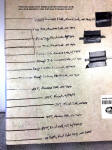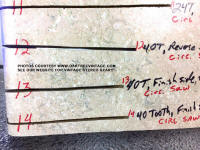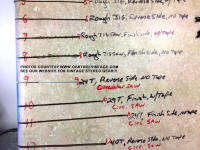TAPCO / EV 100M
ENTERTAINER INFORMATION REFERENCE PAGE

(Unrelated photo to be replaced)
Construction
started 2/7/2022:
I have owned and used a Tapco 100M Entertainer powered mixer for
decades, starting in the early 90's, which was about a decade after it
was introduced. My Orion Blue book shows them ranging from 1982 thru
1991, but one of mine has an internal date of 1981 (although that could
still support a 'marketed date' of 1982 as the internal date is when it
was manufactured, although typically units will start being made
available earlier, not later). I have see a couple references on the web
stating either 1981 or "late '70's" as a starting time period.
Regardless, they started somewhere in that time period (if I find out
more accurately I will post that info), and were originally designed and
marketed by "Tapco" which was a company founded by Greg Mackie (of
"Mackie" electronics).
Tapco built some rugged, affordable units. Many garage
bands in the late 1970's and early 80's used the original TAPCO mixers,
ie; 6000 series "6000", "6001", "6002" etc (remember having to use a
pair of pliers or Vise Grips to turn the controls if the garage was too
cold? I do!!!) They also had a dual, graphic EQ, model 2200 and a stand
alone, Analog / Spring Reverb, model 4400A (I had both of those at
different times too). My more recently acquired Tapco 100M is internally
dated 1986.
These are great powered mixers for small to medium
sized groups / gigs, or for singles / duos that need more inputs for
sequenced keyboards, or multi-media inputs, or for rehershal / garage
band or for using any of it's aspects separately or in combination with
other units / gear. Separately it's two 100 Watt power amps, Two 8-Band
graphic EQ's and a 10 Channel Mixer for expanding another mixer. Use the
built-in power amps to power another system. Use other, larger power
amps with the mixer. Use the EQ to simply eq one acoustic guitar. The
combinations can be endless. They're in a very durable package, and
quite portable.
I use mine with Bose 800, Bose 802 and Bose 901 Series 1 and / or Series
2 speakers, but they originally were designed to come with a great pair
of EV 100S, blow-molded plastic enclosed speakers that sounded and
performed great (and were also in a very durable, blow-molded, plastic
case).
I recently decided to do some long overdue maintenance
on my main, 1981 model as ever since I purchased it second-hand, the
meters have had an issue. They were cyclically 'pulsing' thru the first
2-3 segments about 3 times per second, and I wanted to see if I could
address that. They still performed their main function, but the
'pulsing' was distracting. I also knew it needed some pots / controls
cleaned, had one of the faders that had a mechanical issue when moved
all the way down and just an overall check out / cleaning as well. My
second one also had dirty / noisy controls, a couple faders that had
'mechanical' issues, and it's RCA / Tape input jacks were broken away
from their moorings.
Tapco 100M Entertainer Powered Mixer
ser #...0011.
Disassembly is
fairly straightforward, but re-assembly can be tricky, only because of
the 'speed nuts' that don't always stay attached or in-place on the
plastic case.
Before work was started on it's cleaning (pots / faders etc), I wanted
to attempt to address the 'pulsing' meter issue. I got acquainted with
the power supply board. It divides power out for the Mixer section, the
48V phantom power and the meters. The meters are supposed to be supplied
with +18VDC, but the power supply board was only producing ~7.4 Volts. I
substituted / swapped the power supply output from the other #...093
unit's power supply to the mixer of #...0011 and the meters worked. I
also inverted the test, and the meters of #.0093 didn't work on the
power supply of #...0011.
I had the proper input voltage to the circuit of 25'ish Volts coming
into that section of both units, but on #...0011 only had the 7.4V
coming out. After testing the voltage regulator and associated
resistors, I couldn't find any issues. Then using my Huntron Tracker,
and measuring the associated zener diode of both units, found
substantial differences in the traces. Based on that I ordered the
proper 1N4746, 18 Volt, Zener diodes and looked at those on the tracker
compared to the 'good' one from #...0093 and they matched. Installing
that diode allowed the proper 18 Volts (actually about 18.4V) to the
meters, which cured the 'pulsing meters' issue. Yea!!! Finally, after
about 20 years of watching that when ever I used that mixer. I also went
ahead and changed that diode on the other mixer, which brought it's
meter Voltage up from ~17.4 Volts to ~18.4 Volts. It's meters functioned
properly either way.
Both mixers had a couple of their linear faders that
were 'loose' or had a lot of play and / or were cutting out when pulled
all the way to the bottom. Upon inspection, I discovered that they 'at
issue' faders had taken a blow to their knobs, which pushed them back
into the mixer, which simply pushed their backing plates out of their
retention clips. I simply moved the fader sleds up their path, splayed
out the metal retaining fingers, pushed the plates back into place, and
re-bent the fingers back down against the backing plates. Problems
solved on both mixers. (they're built with Alps brand faders btw.).
I also cleaned all the pots / faders / controls on both mixers.
As long as I was doing all of the above, I re-capped
both power supply boards, and the amp / driver boards and fully tested
the large filter caps (both for ESR and a full gamete of tests with a
Heathkit IT-11. I also (post) tested all the caps I removed and they all
tested as new!!! Yes, really. I also tested all the mixer electrolytic
capacitors in the mixer section in circuit with our Creative Electronics
ESR meter.
Tapco 100M Entertainer Powered Mixer
ser #...0093.
#...0093 also had the RCA / TAPE inputs broken away from their moorings.
I feared that they were in a plastic housing that had disintegrated.
Fortunately they had both simply become broken away at their solder
joints and only required a 're-flow'
TAPCO / EV 100M ENTERTAINER FEATURES:
- 10 Input Channels, with 1-8 featuring Transformerless,
Balanced XLR Mic inputs and 1/4" Hi-Imp inputs and full compliment of
controls. Channels 9 & 10 were for Hi-Level / Line-In sources such as
Tape Decks, Keyboards, Drum Machines or other mixers etc.
- Dual 100 Watt power amplifiers (150 Peak Watts) that could be assigned
for L & R Stereo output or for running 'Mains' from one and 'monitors'
from the other.
- Dual 8-Band, Graphic EQ's that defaulted to L & R, but could be
assigned to "Mains" and "Monitors" or via the very versatile patch bay,
to any individual channel
- Built-In Spring Reverb with Foot Switch defeat and Peak Limited
- Pre-Gain control on channels 1-8 with 'Clip Indicators'
- Channels 1-8 feature both 'Pre' and 'Post' fade AUX's (Monitors and
Effects)
- Full Patch Bay allows complete access, both In and Out to Mixer, EQ's,
and Power Amps which means that any aspect of it is completely
assignable or usable separately
- Built-in, 48V Phantom power for channels 1-8 (not individually
assignable)
- Fluorescent, Dual Bar graph meters
- Full size / length, 2-Spring, Reverb tank (not the shortie that you
see in most modern gear with spring reverb)
- Max Power output circuit (prevents amp clipping)
EV / TAPCO 100M SPECIFICATIONS:
Power Output: 100
Wpc @ 1kHz
THD (Amps): < 0.02%
@ 100 Watts / 1k
THD (Mixer):
< 0.02% @ +4 dBu
Channel EQ: Low
±15-18dB @ 100Hz,
Mid
±12dB @ 3kHz,
High
±15-18dB @ 10kHz,
S/N: -100dB below full amp
output (all faders down)
Output Impedance of Power Amps:
4 Ohm min
Dimensions &
Weight
(Tape Deck):
20" W x
19"D x 8" H & 36 lbs
More specifications listed in the EV / Tapco 100M Entertainer Owners /
users manuals / pdfs which are available on the web as free downloads
TAPCO / EV 100M ENTERTAINER "REAL
WORLD / 40+ YEAR LATER" FEATURES:
These are things
that make the unit still usable 40 years after it's inception (I venture
to state that the VAST MAJORITY of gear built today and in the past
dozen+++ years will not be able to be used very far into the future and
certainly not have their lifespan measure in decades due to anemic SMD
parts / build / design prevalent in most, modern chinese / CHEAP
gear)
- Real 'Metal' housed
potentiometers
- Pots with Metal shafts
- Shaft nuts securing EVERY potentiometer (means that every time you
manipulate a control, you're not flexing the solder joints / circuit
boards. Most mfg's of 'musician quality' gear stopped this in the mid
1990's_
- NO SMD components. Circuit boards are populated with normal, FULL SIZE
components that most technicians are still willing and able to work on
- Metal cased, TO-3 Mosfet output transistors (no CHIP output)
- Patch bay bolted to sheet metal and not directly soldered to main
circuit boards
- All I/O jacks (except for the RCA's which is why they broke on one of
mine) are fastened to the sheet metal housing with shaft nuts
- Not really a part of it's original design parameters, but no "black
legged" transistors (at least not in either of mine)
- Huge, Full-Wave bridge rectifier
- Huge, 12,000uF / 75W filter capacitors
- Separate circuit boards enable
easier service
- Multi-pin connectors on circuit boards enable easier service
- All potentiometers have
access ports for cleaning
- Any channel strip can be independently removed for exchange /
servicing
I also tested the transformer secondary Voltages of both power
transformers. Results coming soon.


(Unrelated photo to be replaced) (Unrelated photo to be replaced)


(Unrelated photo to be replaced) (Unrelated photo to be replaced)







